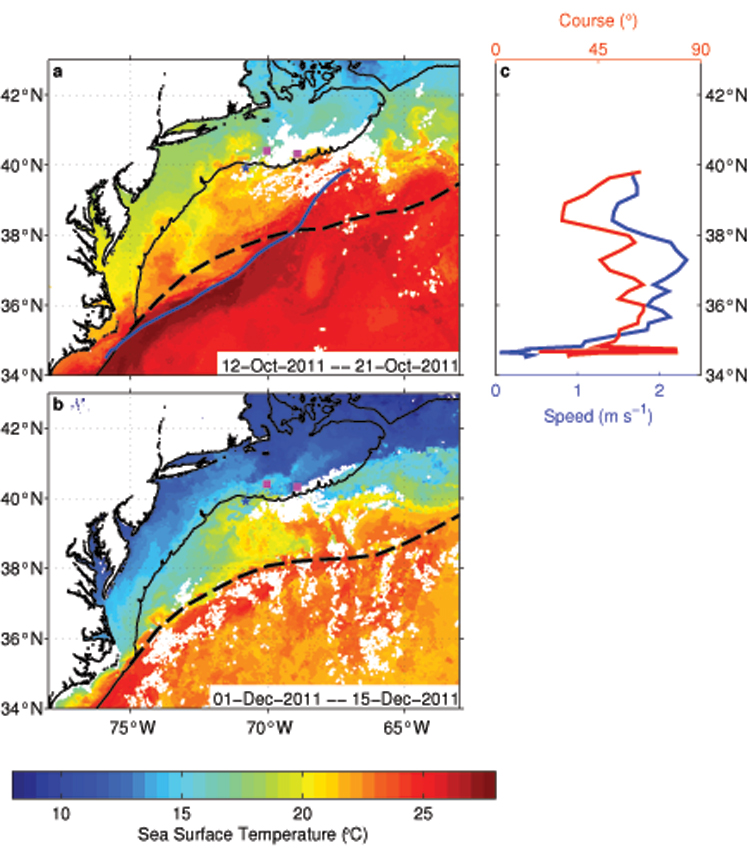Physical oceanographer Glen Gawarkiewicz promised that he would launch an investigation into the phenomenon, and began collecting data and creating a record of the Gulf Stream's path during the fall of 2011, the institute said in a prepared statement.

"First, they tapped into data collected by a program called eMOLT, a non-profit collaboration of fishing industry, research, academic and government entities, run by James Manning of National Oceanic and Atmospheric Administration's Northeast Fisheries Science Center. For more than a decade the program has recorded near-bottom ocean temperatures by distributing temperature probes to lobstermen," WHOI officials said.
Together with Manning, WHOI scientists Robert Todd and Magdalena Andres collected a series of temperature readings from a pair of different eMOLT sites located on the outer continental shelf. They discovered two separate events where the temperature of the waters increased by 6.2 degrees Celsius and 6.7 degrees Celsius, ultimately reaching highs in excess of 18 degrees Celsius as a result.
Gawarkiewicz called those temperature spikes "dramatic events for the outer continental shelf, at least 2°C warmer than we've seen since 2001," and added that the 18 degree Celsius readings in that region in late fall were "extremely high" for that place at that time. In fact, WHOI reported that the maximum recorded temperature at one of the sites for the month of December was the warmest recorded in six years worth of observations at that location.
"Gawarkiewicz and his colleagues collected additional data on water temperature and salinity from December 4, 2011 through January 4, 2012, from instruments on temporary test moorings placed 12 km south of the shelfbreak by the Ocean Observatories Initiative (OOI)," the institute said. "The researchers compared those salinity measurements to historical data, and discovered that high salinity levels - consistent with the salinity of waters carried by the Gulf Stream - coincided with the warming periods."
"The extent and duration of the two 2011 warming events combined with the high salinity observed by the researchers suggested the cause was not a transient warm core ring, but the Gulf Stream itself that carried warm, salty water to the outer shelf," they added. "To solidify that finding, Gawarkiewicz received serendipitous help from students in the Marine Advanced Technology Education (MATE) program at Cape Fear Community College in Wilmington, NC, who had deployed a surface drifter during the period coinciding with the two warming events."
Those drifters use satellites to report their location approximately every six hours, allowing the WHOI scientists to analyze their travel path and velocity. Ordinarily, they tend to drift towards the shelf at speeds of roughly one knot, Gawarkiewicz said. However, the ones used in the experiment were moving towards the shelf at much faster speeds - approximately 2.5 knots - and traveled a total of 580 miles in just eight days.
"The periods of high speeds for the drifters coincided with the records for high temperatures on the outer shelf, which told the scientists that the core of the Gulf Stream had diverted to 39.9°N at 68°W - 125 miles north of its mean position, further north than had ever been recorded by satellite altimeters at this particular longitude," the researchers said in their press release.
Those findings could have "significant longer-term implications," they note. "Studies have shown that temperature increases of 2°C have caused major shifts in silver hake populations, for example, and in spring 2012, migratory bluefish and striped bass were observed off the coast of Cape Cod much earlier than in previous years. But, the scientists say, more research is needed to determine just how the Gulf Stream's behavior in 2011 affected the continental shelf ecosystem and marine organisms."
Gawarkiewicz's team is uncertain what might have triggered the Gulf Stream's shift, though they said that it would have occurred shortly after Hurricanes Irene and Katia pummeled the east coast with precipitation and that those storms could have played a role. Additional research will be needed to determine the cause of the phenomenon. For the time being, the WHOI researchers are preparing to monitor the Gulf Stream again this fall, and are hoping that they will eventually be able to predict when something like this will occur.



Comment: When the oceans start moving in ways they don't normally, you know it's time to pay attention!
For more in-depth reading on the possible significance of this event, check out Fire and Ice: The Day After Tomorrow